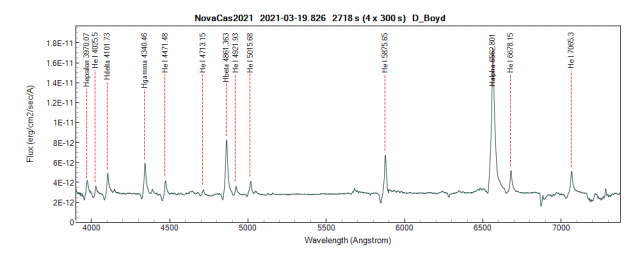2021 March 20
Bright Nova in Cassiopeia!

I would like to alert members to a bright (8th mag) nova in Cassiopeia discovered on March 18. It is currently a binocular object and well worth a look if you get clear skies. Moreover, it’s close to the open star cluster M52, making it a photogenic field as shown in the image above from Nick James in Chelmsford on the evening of March 19 (the nova is marked near the bottom – the Bubble nebula is in the vicinty, too – see image further down). Here’s the story.
Yuji Nakamura (Kameyama, Mie, Japan) reported the discovery of a possible nova, PNV J23244760+6111140, on March 18.4236. This was confirmed spectroscopically as a classical nova in a report in The Astronomers Telegram 14471 (Hiroyuki Maehara (National Astronomical Observatory of Japan), Kenta Taguchi (Kyoto University), Yusuke Tampo (Kyoto University), Naoto Kojiguchi (Kyoto University), Keisuke Isogai (Kyoto University).
Nova Cas 2021 is located at RA 23 24 47.73 Dec +61 11 14.8 (J2000.0). It has now been designated V1405 Cas
This is a bright nova, reasonably well placed in the evening sky and further observations are encouraged. The field is circumpolar from UK and is an easy binocular object. Charts and sequences are available from the AAVSO Variable Star Plotter; a 3 degree chart is here. Note that you can scale and orientate the chart to your preference .
Follow the unfolding story of this nova on the BAA Forum.
Please submit your observations to the BAA Variable Star Section. Binoculars are ideal for visual estimates of the nova’s brightness, but DSLRs and CCDs can also be deployed. It would be great to see your images on BAA Member Albums.
Spectroscopy is also encouraged. A spectrum by David Boyd on March 19 was recorded with a LISA spectrograph on a C11 during a short break in generally overcast skies (see below). It shows strong emission lines of the hydrogen Balmer series and He I. There are P Cygni profiles extending to around -2500 km/s relative to the rest wavelength on all emission lines. The spectrum was calibrated in absolute flux using currently recorded B and V photometry which gave V = 7.77+-0.04 and B-V = 0.50.

Jeremy Shears
Director, BAA Variable Star Section
The image below was supplied by Gary Poyner. Taken on March 20.256, it is a 20 seconds exposure on TV 85mm GXF refractor at f/5.6, SBIG 10 XME CCD, Paramount ME II using Canary 2 telescope at SLOOH, Tenerife. M52 is near the top of the image and the Bubble Nebula (NGC 7635) is to the right.

| The British Astronomical Association supports amateur astronomers around the UK and the rest of the world. Find out more about the BAA or join us. |
